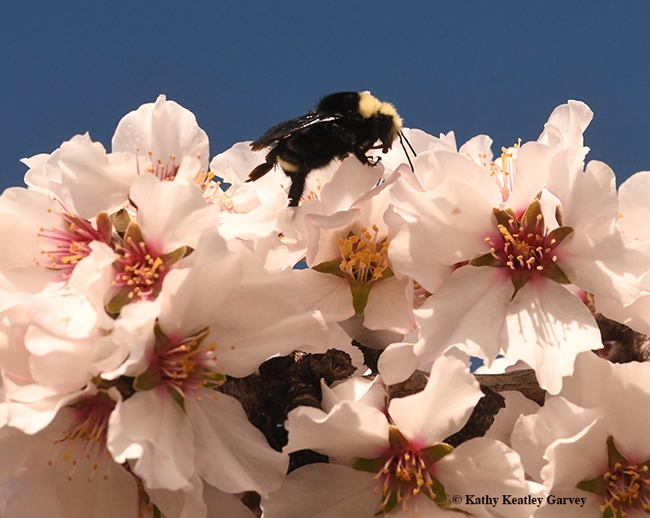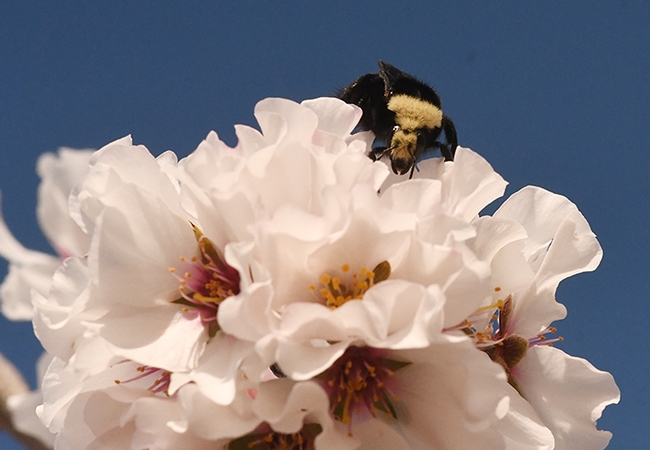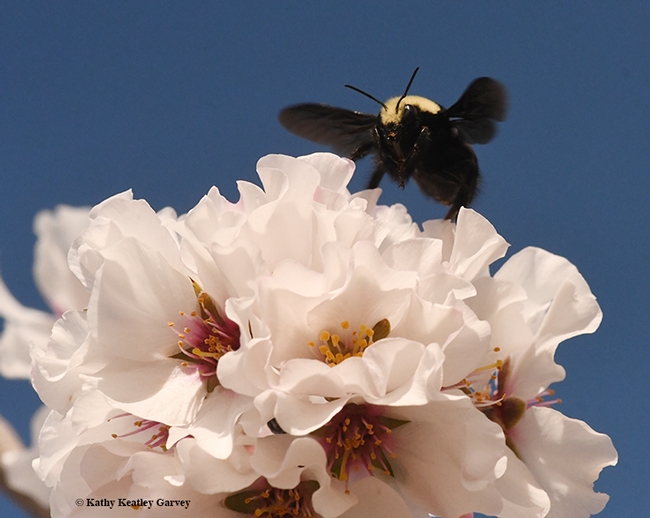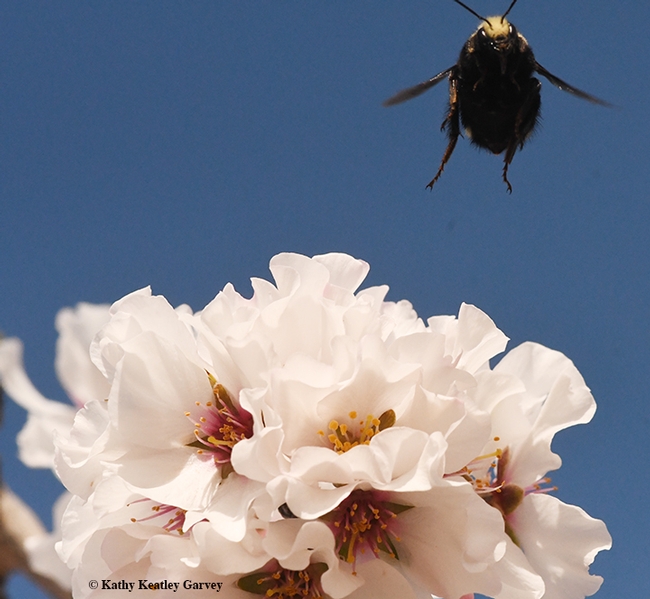- Author: Kathy Keatley Garvey
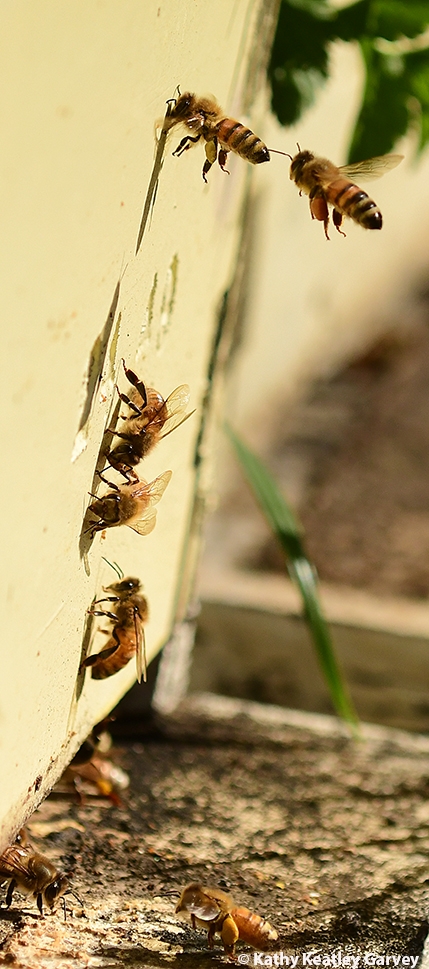
Of course, you go.
Almond pollination season is a delight to see and record. Almonds rank No. 2 among California's most valued agricultural commodities, right behind dairy products.
Sadly, glamour photographers often trespass on private property to take images of high fashion models in evening gowns and high heels, or to pose newly engaged couples and newlyweds. (One professional photographer even lists "40 poses for spring engagement photos in almond orchards.")
Apparently there's money to be made from the hard work of the farmers.
However, those of us born and raised on a farm appreciate the land, crops and farmers more than we do trespassing glamour photographers looking for a backdrop.
Almond pollination season ought to be about almond pollination.
Latest statistics from the U.S.Department of Agriculture's National Agricultural Statistics Services, show that "California's 2020 almond acreage at an estimated 1,600,000 acres, 5.3 percent higher than the 2019 acreage of 1,520,000. Of the total acreage for 2020, 1,250,000 acres were bearing, 5.9 percent above 2019, and 350,000 acres were non-bearing, up 2.9 percent from 2019. Preliminary bearing acreage for 2021 is estimated at 1,330,000 acres."
"Fresno, Kern, Stanislaus, Merced and Madera were the leading counties. These five counties accounted for 73% of the total bearing acreage."
Almond pollination season usually starts around Feb. 14 and ends around mid-March. Growers advocate two hives per acre. But since California doesn't have enough bees to pollinate the almonds, beekeepers truck their bees here from all over the United States. The Almond Board of California points out that "two-thirds of the nation's commercial honey bees hives converge in California."
This year almond growers and beekeepers faced frost ("cold snap"), rain, hail and a myriad of hive thefts. (In addition to trespassing photographers.)
Sadly, on our visit to an isolated Esparto almond orchard on Feb. 16, we not only saw the beginning of the almond pollination season, but the beginning of more work for the land owners--a discarded mattress, tossed potato chip bags, crumbled candy wrappers, broken beer bottles and other trash.
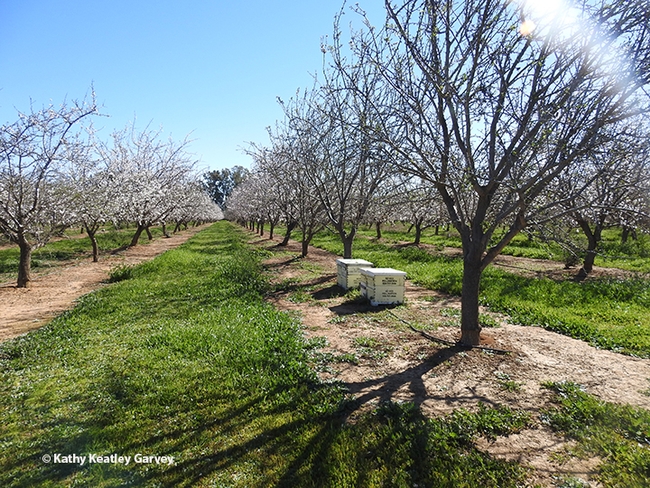
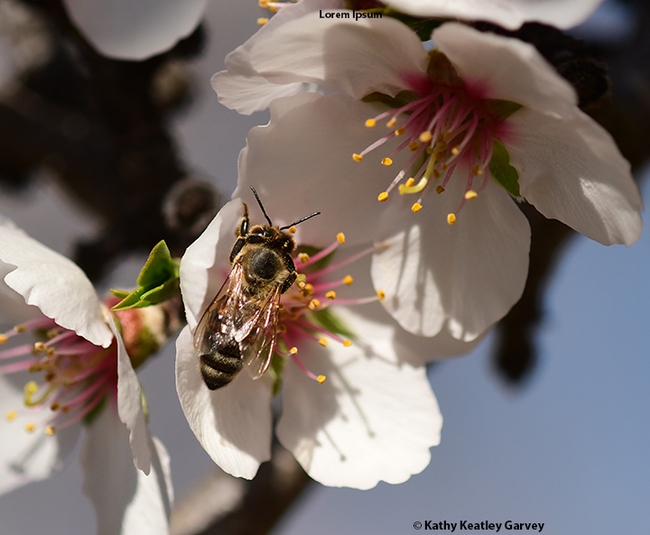
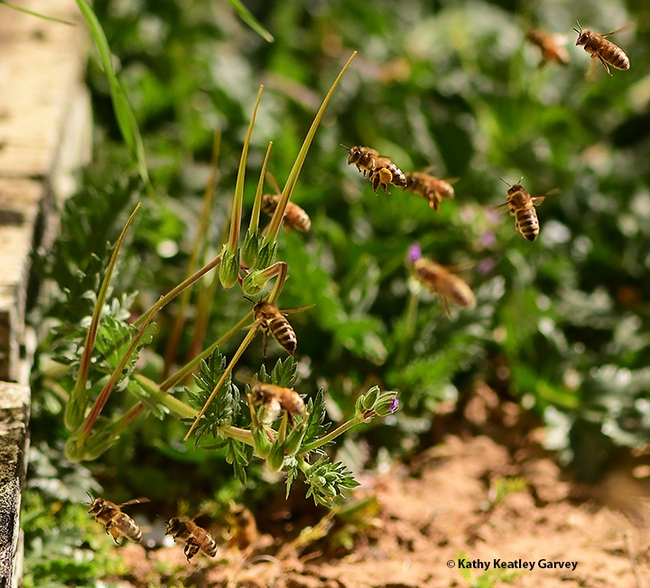
- Author: Kathy Keatley Garvey
Hear that buzz? California almond pollination season is approaching.
The season usually begins around Valentine's Day, Feb. 14, but we usually see the first-of-the-year almond blooms in mid-January in a hot spot near the Benicia marina.
That's where we saw them on Jan. 23, but they've bloomed in that vicinity as early as Jan. 1.
Almonds are big business in California, a burgeoning big business.
The most report of the California Field Office of the USDA's Agricultural Statistics Service, released April 23, 2020, indicates:
- California's 2019 almond acreage is estimated at 1,530,000 acres, up 10 percent from the 2018 acreage of 1,390,000.
- Of the total acreage for 2019, 1,180,000 acres were bearing and 350,000 acres were non-bearing. Preliminary bearing acreage for 2020 was estimated at 1,260,000 acres.
- Nonpareil continued to be the leading variety, followed by Monterey, Butte, Carmel, and Padre.
- Kern, Fresno, Stanislaus, Merced and Madera were the leading counties. These five counties had 72 percent of the total bearing acreage.
It takes about two bee colonies per acre to pollinate the California almonds. Since California can't meet that requirement--we don't have enough bees!--the little agricultural workers are trucked here from all over the United States.
According to Nov. 23, 2020 article, "2021 Almond Pollination Outlook and Other Considerations," published in West Coast Nut:
"Idaho, North Dakota and Florida remained the top three states shipping colonies into California. Many honey bee colonies are transferred from the Northern Great Plains to the Pacific Northwest after honey production is finished to be held (often indoors) until almonds bloom in California. So, even though Idaho looks like the top shipping state according to CDFA border shipment data, many of those colonies in reality are coming from elsewhere. The shipment of colonies to storage in the Pacific Northwest is a trend that looks to continue into the future. Many beekeepers have seen lower mortality rates from storing colonies indoors over the winter."
Hear that buzz? It's almost time.
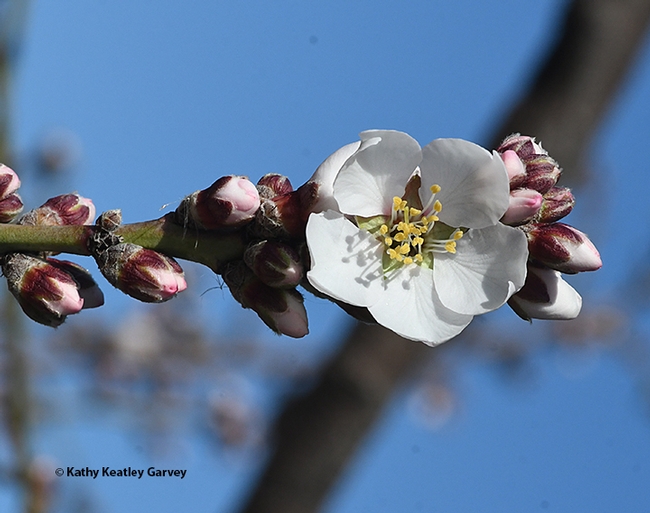
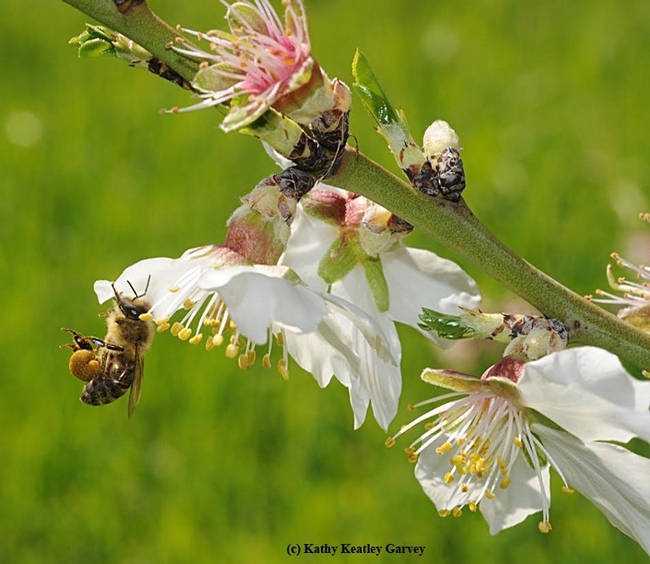
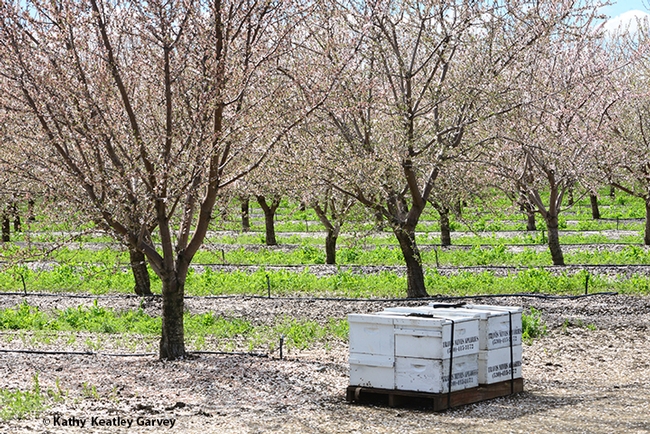
- Author: Kathy Keatley Garvey
Did you hear that buzz in California's almond orchards?
It takes about two colonies per acre to pollinate California's 1.2 million acres of almonds. That's about 2.5 million bee colonies trucked here from throughout the country.
And now the 2020 almond pollination season, which began around Valentine's Day, is ending, not with a buzz, but with somewhat of a bang as growers worry about whether they'll have enough bees for next season.
In a Jan. 22 article in Ag Alert, assistant editor Christine Souza covered the situation well. In noting that California has some 1.2 million bearing acres of almond trees, she pointed out: "As another 300,000 almond acres come into production in the next few years, beekeepers and farmers say an additional 600,000 beehives will be needed for pollination. Achieving that could be somewhat daunting, as beekeepers report annual bee losses due to challenges such as reduced forage, the Varroa mite and pesticide-related issues."
In a forecast article published Jan. 6 in West Coast Nut on "2020 Almond Pollination Market: Economic Outlook and Other Considerations," Brittney Goodrich, assistant Cooperative Extension specialist, UC Davis Department of of Agricultural and Resource Economics, wrote that the total yield in pounds per acre is "projected at 1,880, down 10 percent from 2019 (United States Department of Agriculture (USDA) National Agricultural Statistics Service (NASS) and California Department of Food and Agriculture (CDFA), 2019). Not all of this was due to poor pollination, growers also experienced less than ideal weather conditions throughout the rest of the growing season."
Goodrich also mentioned that:
- "As of October 15, 2019, almond prices were between $2.63 to $2.98 per pound depending on the variety. Prices have remained fairly steady in this range since 2016 (Champetier, Lee, and Sumner, 2019). Almond returns per acre have also remained fairly steady since 2016, though these returns seem small when compared with the 2013-2015 time period with almond prices well above $3 per pound."
- "Pollination expenses as a percentage of operating costs have increased from 6.7 percent in 1998 to 20 percent in 2016 (Champetier, Lee, and Sumner, 2019)."
- "As expected, counties in the San Joaquin Valley have the highest amount of planted acreage."
- "With the exception of Contra Costa and Sacramento counties in Northern California, increases as a percentage of bearing acreage by county range from 0.2 percent to 6.5 percent of total bearing acreage. Contra Costa and Sacramento counties each saw increases over 40 percent, but combine for a total planted acreage of 217 acres in 2018."
- According to the California State Beekeepers' Association, "average almond pollination fees have gone up around $5 per colony per year since 2017. The range in fees seems to have grown over time, in 2019 there is more than a $60 difference per colony between the lowest and highest fee reported. From talking with others in the industry, the average fee of $195 in 2019 may be on the lower side. Fees for a majority of colonies likely ranged from $200 to $220 per colony in 2019."
Meanwhile, take a look at the honey bees foraging on an almond near the Harry H. Laidlaw Jr. Honey Bee Research Facility on Bee Biology Road, UC Davis campus.
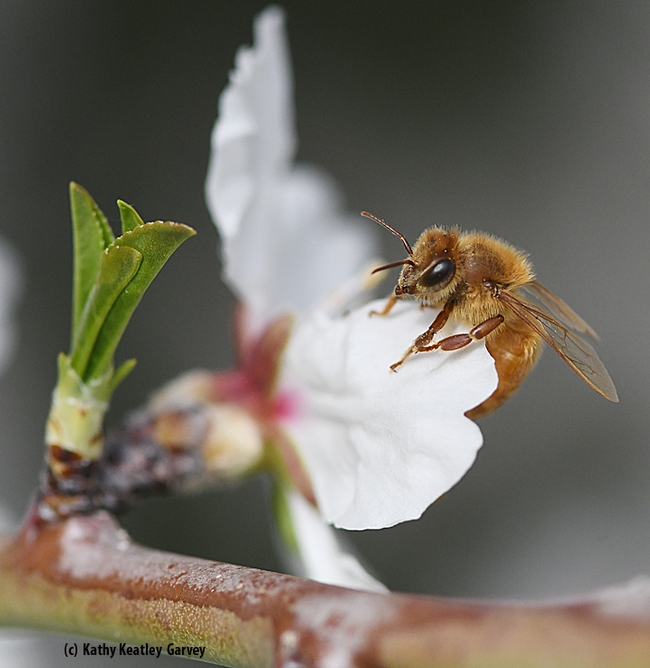
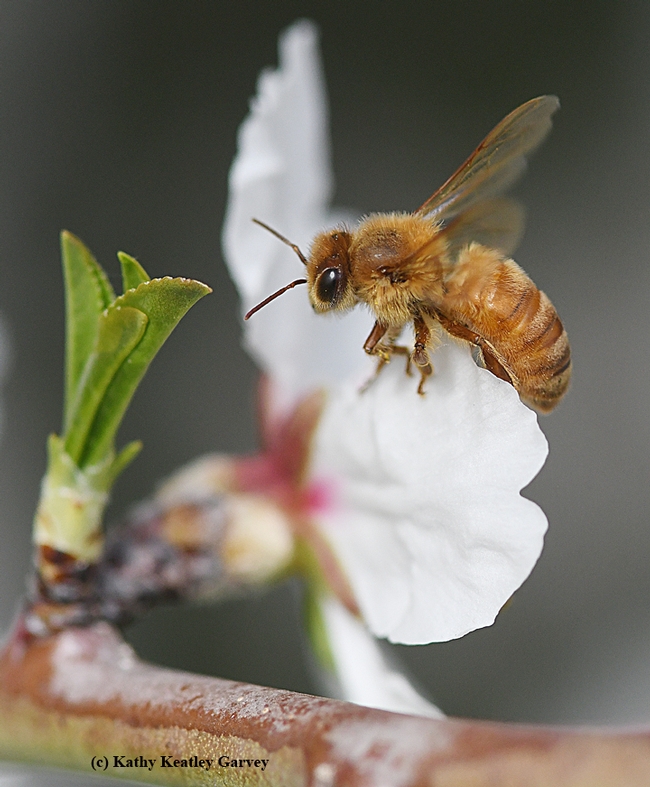
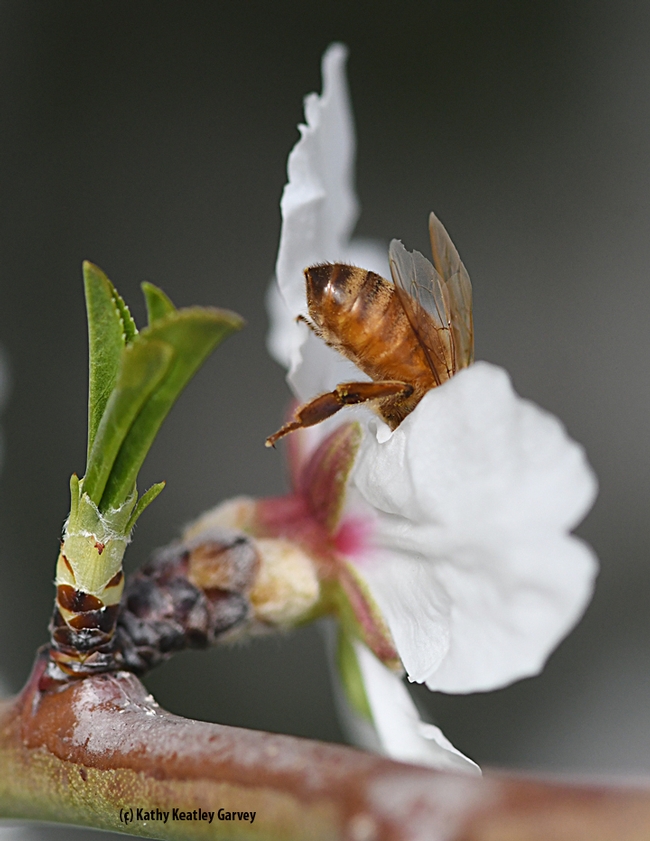
- Author: Kathy Keatley Garvey
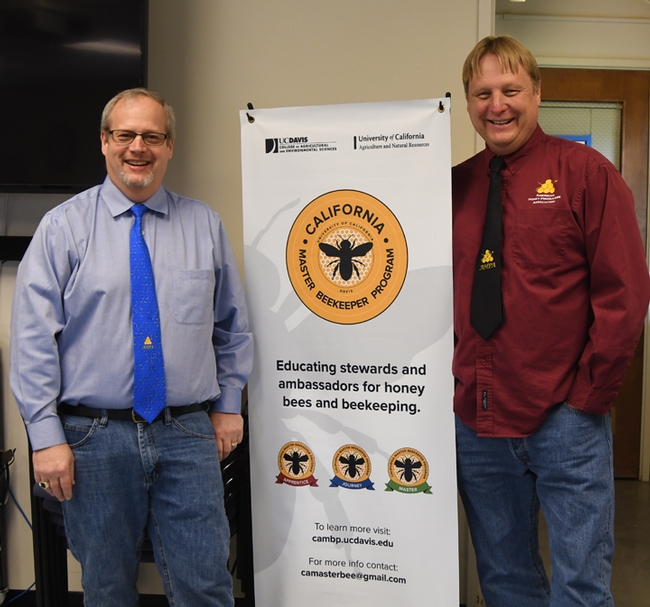
Beekeeper Kelvin Adee, who hails from Bruce, isn't experiencing any of that right now.
He's in California--and so are his bees for the almond pollination season.
Adee is the president of the American Honey Producers' Association, which is meeting Jan. 7 through Jan. 12 for the 2020 North American Honey and Pollinator Summit and Trade Show at the Hyatt Regency, Sacramento.
Adee and other members of the executive board met Tuesday morning, Jan. 7 at the Harry H. Laidlaw Jr. Honey Bee Research Facility, Bee Biology Road, University of California, Davis, for a pre-conference session. They then participated in the ribbon-cutting ceremony and tour of the newly constructed USDA-ARS bee research facility, corner of Bee Biology and Hopkins roads. (See news story)
“Is it true that the national tree of South Dakota is the telephone pole?” we asked him during the luncheon.
He laughed and said the state does indeed have wide-open spaces. The population in Bruce is sparse, too. In fact, the 2019 census recorded the population at 204.
Bruce is the home of Honey Days Festival, held the last week of July. In fact, Adee Honey Farms, known as the world's largest producer of honey (and a prominent employer in town) inspired it.
But back to Kelvin Adee. He's a third-generation beekeeper. He actually lives in nearby Brookings but works out of the home office in Bruce.
His biosketch indicates: “Growing up in a commercial beekeeping family, Kelvin developed his interest in beekeeping at a young age, learning the business and the science from his father. As a third-generation beekeeper, he also gathered beekeeping knowledge from his grandfather, uncles and cousins who have been involved in beekeeping operations." Adee attended college in Bartlesville, Okla., receiving a bachelor's degree in business and accounting. and then returned to the beekeeping business. He has been actively involved in growing the business into an 80,000 colony farm operating in multiple states, according to the biosketch. He oversees the queen rearing/nuc operation in Mississippi and Texas along with company-wide honey production.
His biosketch also relates: “In addition to beekeeping, Kelvin has served on boards in various positions for the state beekeeping association and the national association. He is active in his community and his church and has served numerous years on the school board. Kelvin married his high-school sweetheart Darla and recently celebrated 37 years of marriage. They have four grown sons and five grandchildren. Three of Kelvin's sons have joined him working full time in the beekeeping business, and the fourth son works in crop production ag. He also enjoys working in the business with his father, Richard, brother, Bret and his sister Marla.”
Meanwhile, it's brrrr cold in Bruce, but here in the Davis area, it's warming up. Plants such as tidy tips, Kniphofia "Christmas Cheer" and manzanita are blooming on the UC Davis campus.
Almonds usually start blooming around Valentine's Day, heralding the beginning of almond pollination season. Hear that buzz? No? It's coming.
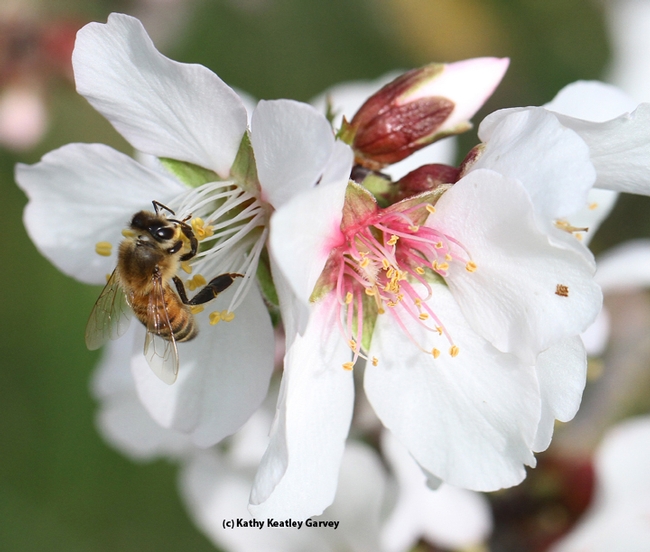
- Author: Kathy Keatley Garvey
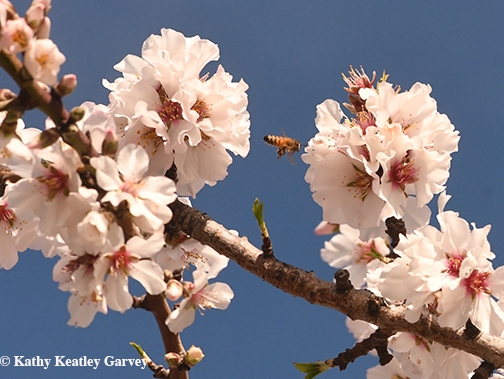
Take Benicia, Solano County. Its little hot spots near the Carquinez Strait--think trees growing near sun-warmed asphalt--yield early almond blooms, often as early as New Year's Day.
At the Matthew Turner Park in Benicia, today, honey bees buzzed around the almond blossoms, gathering pollen and nectar. But the honey bees were not alone.
Yellow-faced bumble bees, Bombus vosnesenskii, were foraging, too. It's always a treat to see honey bees in the almonds, but it's a double treat to see a bumble bee.
Pollination of California's almond acreage is as intense as it is huge. The 2016 almond acreage totaled 1.2 million acres--940,000 bearing and 300,000 acres non-bearing, according to a report issued in April 2017 by the California Department of Food and Agriculture, in cooperation with the National Agricultural Statistics Service of the U.S. Department of Agriculture. This year, California has more than a million acres of bearing almonds, and each acre requires two bee hives for pollination. The leading almond-producing counties? Kern, Fresno, Stanislaus, Merced and Madera.
Solano County, of course, doesn't make the list, but when you want to see the early almond blooms, it's the place to "bee."
Which reminds us of the research, Synergistic Effectgs of non-Apis Bees and Honey Bees for Pollination Services, published by an international team of scientists in the Jan. 10, 2013 edition of The Proceedings of the Royal Society B. The researchers, including pollination ecologist Neal Williams of UC Davis, found that honey bees are more effective at pollinating almonds when other species of bees are present.
When blue orchard bees and wild (non-managed) bees such as bumble bees, carpenter bees and sweat bees, are foraging in almonds with honey bees, the behavior of honey bees changes, resulting in more effective crop pollination, said lead author Claire Brittain, then of the Neal Williams lab. She earlier worked as a post-doctoral fellow at Leuphana University of Lüneburg, Germany.
“These findings highlight the importance of conserving pollinators and the natural habitats they rely on,” Brittain told us in a news release. “Not only can they play an important direct role in crop pollination, but we also show that they can improve the pollination service of honey bees in almonds.”
Agroecologist Alexandra-Maria Klein, now a professor at Leuphana University, served as the project lead while a postdoctoral fellow in the UC Berkeley lab of conservation biologist/professor Claire Kremen. In fact, Klein and Kremen initiated the project in 2008 and continued working on the project together in 2009 and 2010. Williams joined the team in 2010.
Native pollinator specialist Robbin Thorp, now a distinguished emeritus professor of entomology at UC Davis, identified 50 different species that the team found. They included bumble bees, small carpenter bees, sweat bees, digger bees, mining bees and blue orchard bees.
Take a look around you during the almond pollination season. The honey bees are not alone.
